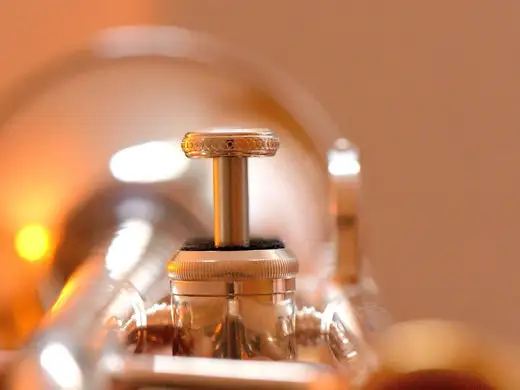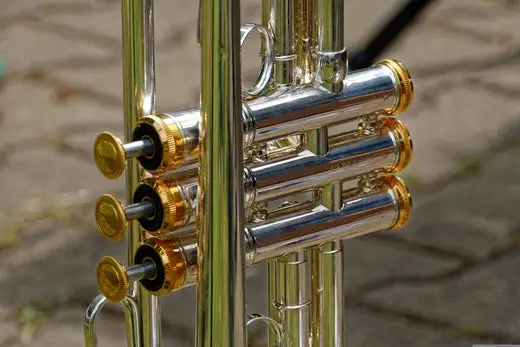Toxic Trumpets
Back in the days of chalk and erasers, the progress of the school day could be charted by the gradual buildup of chalk on the board. Squinting to distinguish my math problems from the gray powder of lingering dust that surrounds them – it must be close to lunchtime.
Each day we looked forward to who would be chosen to clean the board with a wet sponge, magically revealing a glossy, pristine black surface.
As brass players, we fall into the comfortable fiction that our instruments are clean inside. After all, the outside is so shiny!
The ugly truth is this: what goes into our instruments stays there. Sugar in our saliva, particles of food, and whatever else the daily tooth brushing missed when we brushed after lunch. Didn’t brush after lunch? The onslaught intensifies: fire the artillery, bring on the chicken nuggets.
Red Rot
The brass used to make musical instruments is an alloy of zinc and copper – usually in a ratio of 30% to 70% respectively. In the most extreme cases of instrument neglect, the trumpet or brass instruments will develop red rot, which is the breakdown of the zinc portion of the alloy, leaving the metal weak and fragile.
Red rot shows up as a reddish blotch on the outside of the brass. However, this is just the visible evidence; the pipe is being eaten away from the inside out, and eventually holes will develop. Once detected, red rot can be slowed, but eventually the affected tubing will need to be replaced.
The lead pipe is the most common area for red rot to develop. This is the first stop for food particles, minerals, and acid in the saliva leaving the mouthpiece; most larger food particles get deposited here, although some continue through to other parts of the trumpet. Besides the lead pipe, other areas prone to corrosion are the tuning side crooks and the crook attached to the third valve casing.
To prevent red rot or slow its progression, students should remove as much moisture from the trumpet as possible when they have finished playing. A proper and thorough cleaning once a month is key to preventing this problem, as well as maintaining the overall health and playability of the instrument.
Share these simple guidelines with your students:
- Carry a toothbrush, and always brush your teeth before you play.
- If you can’t brush your teeth, rinse your mouth with water thoroughly instead.
- Empty all water from your trumpet after each practice and performance.
- Run a clarinet swab through the lead pipe and tuning slide before putting it away.
- Run a mouthpiece brush through the mouthpiece twice a week.
- When possible, don’t eat before you play.
- Avoid acidic beverages like tea, coffee, lemonade, and soda before you play.
- Avoid milk-based beverages before playing; they thicken the saliva and can cause sticky valves.
Cleaning the Trumpet
To clean the trumpet, the students will need to purchase a cleaning kit (available from the local music store) and a few common household supplies. The following items will be needed:
- Mouthpiece brush
- Two clean, dry bath towels
- Cleaning snake
- Hand towel
- Slide grease
- Valve oil
- Soft, lint-free cloth (no paper products; the wood fibers will damage the finish)
- Liquid dish soap (with minimal additives)
- Plastic tub large enough to comfortably fit the trumpet and slides
Cleaning and Polishing the outside of the Trumpet
The brass of a trumpet or other brass instruments is protected with either clear lacquer or silver plating. Acids in our perspiration break down this plating. If students do not wipe their instrument after they play, their sweat will dissolve the plating and eventually begin to eat through the brass itself.
To protect their instruments’ finish, students should wipe the trumpet after each practice with a soft cotton cloth (e.g. an old t-shirt) to remove the oil and acid left by their hands. Students whose perspiration is very acidic need to be especially on top of this. Also, students should polish their instrument monthly with a cloth designed specifically for their finish (lacquer polish cloth or silver polish cloth).
Liquid silver or lacquer polishes are also available, but these should only be used every six months; these strong chemicals will wear down the finish if overused.
Removing the Valves for Cleaning
Students should bathe their trumpet once a month to clean out all the previous month’s bacteria, food particles, and saliva deposits (acid) that are placed in the trumpet each day. If they clean their trumpet on a monthly basis, their instrument will perform better, as well as smelling and looking better.
If you’re serious about having clean instruments in your band, you will have to walk students through the cleaning process in class. While some of this can be done verbally, you’ll want to actually show them how to safely remove the valves, as this is a very delicate procedure!
When the valve is inserted correctly, the holes of the valve will actually line up with the holes in the valve casing. Have students observe this for themselves by pressing down the valve key, removing the corresponding valve slide, and looking into the valve slide opening. If the valve is in the wrong casing or is facing the wrong way, the holes will not correspond, obstructing the airflow.
As you prepare them to remove the valves, let them know that the valves are the most delicate part of the trumpet; dropping one can have disastrous consequences. Have students place the trumpet on their lap, with the bell facing to the right. Then have them unscrew the top valve cap on the first valve. Slowly pull the valve straight up, halfway. There may be a small “1” stamped on it, signifying that it is the first valve.
Now have them look for the valve guide, a small piece of plastic or brass located near the bottom of the spring inside the valve. Both sides of the valve guide protrude from the valve, locking it into place when the valve is inserted into the valve casing.
Students should observe that one side of the protruding valve guide is a little larger than the other. Have them observe whether the large or small side of the valve guide is facing them; they will need this information to correctly re-assemble the trumpet. If they make a mistake, the holes in the valve will not line up with its slide, and air will not be able to pass through.
Have them practice this step with you and make sure all their questions are answered, so they feel confident in bathing their instrument at home, with their parents’ guidance.
Preparing the Trumpet for the Bath
As you walk students through the process of bathing their trumpet, emphasize to them that they should use only liquid soap, not detergent, for the trumpet bath. The strong chemicals in detergent are not safe for their instruments and may scratch or damage the finish.
Then the students should run a lukewarm bath for their trumpet in a large plastic tub or bath tub. Next, they should add a moderate amount of liquid soap – just enough to make the water sudsy. Students may think by more soap will make it cleaner. The opposite is true; too much soap can make it hard to get all the soap off the trumpet. The residue will lead to sticky valves and slides, and can leave a foggy film on the plating or lacquer.
Next, instruct the students to place a folded bath towel next to them on a stable, level surface. In addition, have them place a hand towel nearby for the parts that will not be bathed.
Basically, there will be two places for the trumpet and its parts; a bath towel for the parts that will actually be washed, and a hand towel for parts that need to remain dry.
The parts of the trumpet that do not need to be washed are the top valve caps, finger buttons, pads, and third valve slide stopper. The pads located on the valve stem must remain dry; if they get wet, they will become misshapen and not fit properly.
The parts that will be washed are the three valve slides, valves, mouthpiece, and bottom valve caps. Dis-assemble the trumpet (see below) and carefully transfer each part to the appropriate towel. Each part should be handled with great care; even a tiny ding or dent can cause the trumpet to not work properly.
If any of the valve caps (top or bottom) are stuck, the students should run hot water over them, then use a rubber grip to carefully remove it. If this does not work, emphasize to students not to proceed further: destruction is imminent the moment pliers enter the scene! Have them take their trumpet to a qualified repairman, who has professional tools for this purpose.
Specifics for Disassembling the Trumpet
- Examine the cork on your water key, located on the tuning slide. (Some trumpets have an additional water key on the third slide.) Make sure the cork is in good condition and seals correctly. Gently rub a drop of valve oil into the cork; this should be done weekly.
- Unscrew each finger button from the valve stem. Unscrew each top valve cap and slide it over the stem.
- Place the finger buttons and top valve caps on the hand towel, keeping all of the hardware for each valve together.
- Remove the felt pads from the valve stem and set them on the hand towel. The pads need to stay absolutely dry; keep them well away from the cleaning area to avoid splashes.
- Unscrew the nuts and/or screw on the third valve slide stopper and carefully put them on the towel. Make sure these small parts are safe and cannot slip down the drain! (If they are lost, students can get replacements at the local music store.)
- Place the valves themselves on the bath towel.
- Place the mouthpiece on the bath towel.
- Remove all three valve slides and place them on the bath towel.
- Place the bottom valve caps on the bath towel for cleaning.
NOTE: Never remove the first, second or third slide on the trumpet without depressing the valve of the slide you are removing.
If you forget, the air pressure you have released will create a “pop” and the metal will expand rapidly. Over time, the expansion will become noticeable, and the slide will no longer make a proper seal.
The tuning slide may be moved freely without the need to depress any valves, since it is open at the lead pipe.
Trumpet in the Bath
- Place the trumpet and the contents of the bath towel into the bath. Let them soak for 15-20 minutes to loosen dirt and deposits.
- Run the cleaning snake or mouthpiece brush through each trumpet pipe, valve slide, and mouthpiece. Be careful not to scratch the inner or outer surface of any trumpet part.
- Run the snake through the tuning slide from both directions to remove all dirt and deposits.
- Soak for five more minutes to loosen any remaining deposits.
- Drain the water out of the trumpet, turning it different directions. Run lukewarm water through several times to rinse out any remaining particles. Drain the trumpet and carefully shake out excess water.
- Return each cleaned piece to the bath towel, including the trumpet itself. Dry each section of the trumpet thoroughly with a lint-free cloth.
Reassembling the Trumpet
- Make sure there is no standing water in any pipes or slides, then allow the trumpet to air-dry for two hours.
- Apply slide grease to the raw brass portions of the valve slides and re-insert.
- Apply slide grease to the raw brass portions of the tuning slide and re-insert.
- Apply valve oil to the first valve and insert it into the casing in the correct orientation. Replace its felt pad, top cap, stem, and finger button. Repeat for each remaining valves.
- Insert the mouthpiece. Play a few notes to make sure everything is in place.
Valve Alert
If the students discover that air cannot pass through the trumpet after replacing the valves, have them first check to make sure each valve is in the correct casing, using the numbers printed on the valves. They should turn each valve until they hear a click and the valve is no longer free to rotate, indicating that the valve is in place.
If air still cannot pass, lift the valve out of the casing and rotate it 180˚. They should again hear a click as the valve guide protrusions fit into place. The valve should now be in its correct position.
Do-it-yourself Acid Bath
Even with regular cleaning (and especially without it!), trumpets accumulate deposits in the pipes which cannot be removed by a regular bath. An acid bath gets rid of mineral deposits, stubborn buildup and oils, and any corrosion in the pipes.
An acid bath should be completed at least once a year, especially for high school students whose trumpet hygiene may be inconsistent. A professional acid bath costs around $130; having students do this at home will save money and substantially increase the life of your instruments.
The supplies needed for an acid bath include those needed for a regular bath, plus a plastic tub (this reduces the amount of vinegar needed to a manageable amount), four gallons of white vinegar, and baking soda.
- Perform a regular trumpet cleaning with soap and water.
- Fill a plastic tub with 4 gallons of pure vinegar, and immerse all of the just-washed parts for 15-20 minutes. Do not add water. This is the acid part of the bath.
- Pour out the vinegar and rinse everything thoroughly with water, including the tub itself.
- Add baking soda gradually to running water, stirring constantly. If the baking soda stops dissolving, stop adding! Any undissolved baking soda will leave grit on the slides and in the trumpet.
- Soak the trumpet and slides for 15-20 minutes in this baking soda solution to neutralize the vinegar residue.
- Thoroughly rinse the trumpet and slides in clean water.
- Bathe the trumpet once more using soap and water. This ensures that all vinegar and baking soda deposits are removed. Please note that all residues of both chemicals must be completely rinsed from the instrument.
- Reassemble the trumpet as above.
If a trumpet will be stored for a long period of time, make sure the valves and slides are well-oiled and greased, to ensure they will not become locked from lack of movement. Slides should be fully pushed in to make sure that the raw brass is not exposed to the air.
When storing the trumpet for long periods, ideally it should be placed in a sealed bag with as much air removed as possible. Keep it in the case in a clean, dry environment, and place reminders on your calendar to check it every six months and perform any needed maintenance.
When a brass instrument is correctly cared for, there is no reason it could not last up to fifty years or more. Daily, monthly and yearly maintenance routines will help to ensure the preservation of your valuable investment!







